
How we make soap: small batch soap vs mass-produced soaps
We've been making soaps for 4 years now, and get a lot of questions about the differences between our soaps and other soaps.

Soap is created using base oils and butters, by combining them with water and lye and mixing them till they convert into soap.
A few definitions & explanations:
Base oils and butters we use in our soaps include olive oil, coconut oil, castor oil, rice bran oil, shea butter, mango butter and other nourishing oils.

We do not use palm oil, since palm oil production is causing rainforest destruction and contributing to the extinction of Bengal tigers and orangutans. We have heard some companies use "sustainable" palm oil - we disagree with the standards set by the Roundtable on Sustainable Palm Oil and hold the view that "sustainable" palm oil is a label bought, not earned.
Our lye is food-grade. Lye is an alkaline substance (this means it is the opposite of an acid - both can burn if they are strong enough). Baking soda is an example of a mild alkaline substance, and lye is a very strong alkaline substance. Lye is also used to make food products such as bagels, beer, pretzels, even olives! Lye water used to be naturally manufactured at home by soap makers - boil fireplace ashes with water and you have lye water.
Acids are on the opposite end of the pH scale from alkaline substances. Examples of mild acids are lemon juice, orange juice and vinegar. A strong acid is battery acid, also known as sulphuric acid.
So you use oils to make soap - does that mean it's oily?
Nope. Let's compare it to baking a cake. In the cake batter you add eggs, baking powder, butter, oil, milk, flour, sugar, water, fruit. Mix it together, pour it in the baking pan, and bake for 40 minutes in the oven. After taking it out of the oven, you have a brand new thing, a cake. Once it's baked, you can't take the cake back to its original parts - it will never separate back into eggs, flour and water.
Similarly, when we make soap, the butters, oils and lye turn into a new substance. No leftover lye or oil is remaining in the soap after it's made.
Watch a demonstration of No Tox Life founder Sandee Ferman making soap (at :10 you'll see her pouring the lye water into the oils, starting the soap process!):
Looks fun, doesn't it! We make tens of thousands of bars of soap a year. We are proud members of the Handcrafted Soap & Cosmetics Guild and even hosted an inaugural chapter meeting at our HQ.

So what is different about No Tox Life soaps vs mass-produced soaps?
Our soap is made with simple ingredients: oils, butters, water, lye, and sometimes essential oils. We add natural colorings using clays or plant powders, and we like to use upcycled ingredients such as coffee from local coffee shops or juice pulp from nearby juice shops.

Here's an example of a typical soap we make:

Our soaps are made with olive oil, shea butter, coconut oil and castor oil. Some recipes are different but in general we like this combination as it generates good lather and is palm oil free.
Let's take a look at some mass-produced soaps:
Dove White Beauty Bar

Trick product! This is not actually true soap. (Read the label, never do they call it soap. They legally can't call it soap because it isn't primarily a mix of oils and lye.)
Dove makes "cleansing bars" or "beauty bars" that are combinations of chemicals that make detergent. You can tell from their ingredients there's nothing here to make soap.
INGREDIENTS: Sodium Lauroyl Isethionate, Stearic Acid, Sodium Tallowate Or Sodium Palmitate, Lauric Acid, Sodium Isethionate, Water, Sodium Stearate, Cocamidopropyl Betaine, Sodium Cocoate Or Sodium Palm Kernelate, Fragrance, Sodium Chloride, Tetrasodium Edta, Tetrasodium Etidronate, Titanium Dioxide (Ci 77891)
Dove uses animal ingredients (sodium tallowate) which come from cows. There's pretty much nothing in this list of ingredients that we'd want to use on our skin!
Mrs. Meyer's Clean Day Basil Daily Bar Soap

This is truly a soap although mass-produced. But the first ingredient is Palm Oil and it contains pentasodium pentetate and tetrasodium etidronate which are ingredients we don't want to use.
INGREDIENTS: Sodium Palmate, Sodium Cocoate, Water, Glycerin, Olea Europaea (Olive) Fruit Oil, Fragrance, Ocimum Basilicum (Basil) Oil, Carum Petroselinum (Parsley) Seed Oil, Piper Nigrum (Black Pepper) Seed Oil, Sodium Chloride, Titanium Dioxide, Pentasodium Pentetate, Tetrasodium Etidronate
Palm Oil (first ingredient) is cheap but damaging to the environment and animal life. Pentasodium pentetate and tetrasodium etidronate are added to increase foaming and lather, which we think is unnecessary to add to natural soap. But mass-produced soaps are heated, extruded, and formed in large vats and no longer have the rich benefits of handmade products, so glycerin and lathering ingredients are added to substitute for what was lost in the manufacturing process.
Aveeno Active Naturals Moisturizing Bar

Wait -- do you see it? The name? It's not soap! It's marketed like a soap, and looks like a soap, but it's made of detergents with some thickeners to make it solid. It isn't "natural" and it isn't soap.
INGREDIENTS: Avena sativa (oat) flour, water, cetearyl alcohol, stearic acid, sodium cocoyl isethionate, disodium lauryl sulfosuccinate, glycerin, hydrogenated vegetable oil, titanium dioxide, citric acid, sodium trideceth sulfate, hydrogenated castor oil
So how can you tell if it's "really natural"?
"Really natural" soap will list simple ingredients including oils, butters or fats, water, and lye. It may include natural essential oils and fun additional ingredients like coffee grounds or oats (things you can buy at the grocery store and eat). It will NOT include added glycerin, tetrasodium EDTA, cocamidopropyl betaine, lauric acid and more.
(By the way, glycerin will ALWAYS be in a truly natural soap because glycerin is a part of the soap making process. After the soap is cured, about 10% glycerin remains in a natural soap. The only reason it's listed on mass-produced soaps is because it was siphoned off during the manufacturing process to be added to toothpastes and lotions, and then a little bit was added back into the soap for label appeal.)
Do you want us to critique the soap you use? Send us a message we will be happy to go through the ingredients and explain what each one is there for.

1 comment
Hello, I loved reading all the information about soap, it makes me very cross , because people buy these soaps and the general public, don’t really understand what they are buying, shame on them! For selling such poisonous rubbish . Elizabeth
———
NO TOX LIFE replied:
Hi Elizabeth, Thank you, I’m glad you found the article helpful! Agreed, we can only educate people more which is part of our mission. We want to bring more awareness whether people buy our products or not, making better choices is what counts.